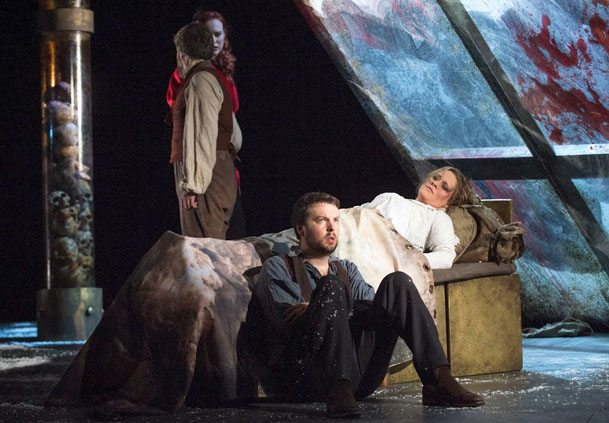Opera is the most complete and complex form of theatre combining, as it does, more aspects and demands than even the most ambitious production of, say, Shakespeare could even aspire to. Because of this, when it is done well, opera is perhaps the most satisfying of the performing arts. It is very expensive and logistically demanding to mount. It also has a rather limited, though dedicated, following so there is always the temptation to play it safe and stick with the tried and tested. So, English Touring Opera’s choice of repertoire could be described as very brave or, if you were of a less charitable bent, foolhardy. Out of the three pieces they are presenting at the Everyman this week, one, admittedly, is a guaranteed crowd puller, one is very little known and the other is downright obscure. Donizetti’s The Siege of Calais is the one in the middle.
It would not be unfair to call even this rarely performed opera obscure. I cannot understand why it is so seldom mounted. The music is as good as any other Donizetti piece and dramatically it is very strong indeed. But it was in the visual presentation that ETO’s production excelled.
As we all know, the actual siege of Calais took place in 1346 when English King Edward III tried to capture the city. If you have seen Calais you would perhaps wonder why anyone would want this God forsaken place or why anyone would want to keep – but that’s another matter. ETO’s Siege of Calais is done in modern dress. The set, costumes and lighting were extraordinary – designer Samal Blak had obviously done his research and found inspiration in images of the siege of Leningrad in World War Two and in the 1957 Jerzy Stefan Stawinski film, Kanal. Derivative is usually used as a pejorative term but I like it when you can see influences; it shows an understanding and context and provides points of reference. Another scene that had a familiar ring about it was the Aurelio’s mock execution, a tableau redolent of Goya’s The Executions of the Third of May, 1808.
Possibly one of the reasons that Siege of Calais is not better known is that there are no hooks – no catchy tunes or nice songs. Catchy they may not be, but strong and powerful they certainly are. The duet at the beginning between Eustachio and Eleonora was beautifully sung (and acted) by Craig Smith and Paula Sides. I liked Mr Smith, he had that sort of quiet dignity about him, a bit like Max von Sydow. Strangely, Eustachio’s son, Aurelio, is played by a mezzo-soprano – a suitably strident Catherine Carby. But it is the ensemble work that both the opera, and James Conway’s production, show real strength. The soldiers in the first scene have that battle-weary, dusty feel to them and the ghost-like figures within the city walls really convey the horror and hopelessness of their situation. Their choral work was excellent as was the orchestra conducted by Jeremy Silver. ★★★★★ Michael Hasted 9/04/15
If you thought The Siege of Calais was obscure, wait till you see The Wild Man of the West Indies (Il furioso all’isola di San Domingo). English Touring Opera is clearly carrying a flag for Donizetti – and why not. First performed in 1833 Wild Man was, apparently, very successful in its day but by 1889 it had disappeared not to be seen again until 1958. This production claims to be the first in Britain in modern times. It’s a bit of an enigma; it’s possible to understand why it has been largely forgotten but difficult to understand why it has not been revived before now.
Well, I think its obscurity can be explained chiefly by the plot which is a bit daft. A Spanish nobleman, Cardenio, has forsaken his former life after being betrayed by his unfaithful wife and goes to live a Ben Gunn existence on a desert island, surrounded by slaves from a nearby plantation. He meets one of the slaves, Kaidamà, whom he believes to be his lost love and wines and dines her/him. Then his actual wife is washed ashore from a shipwreck, then his long-lost brother turns up out of the blue, then he goes blind, then . . .
The piece is very Shakespearian with obvious echoes of The Tempest and perhaps A Winter’s Tale, but Shakespeare was never this silly. That said, this was a fine production. Again the set, this time by Florence de Maré, was superb, as was the ever changing lighting by Mark Howland.
The performances were, as always, excellent. Craig Smith, again in rags, played the deranged Cardenio, a slightly less dignified character than Eustachio in Siege. His estranged wife, Eleonora, was beautifully sung and played by Sally Silver and their long duet in the second half was the high-spot of the evening. The comic relief was provided by Peter Brathwaite as the cheeky put-upon slave, Kaidamà, who was the sort of Caliban character. I particularly liked Njabulo Madala as the plantation manager and the all-male (again) chorus provided the cement which held the piece together. The orchestra again excelled under conductor Jeremy Silver
Despite the weaknesses in the story it was good to see The Wild Man of the West Indies for the first time and ETO should certainly be congratulated for bringing it to the stage. Donizetti composed 41 operas so I imagine this won’t be the last one they dig up. ★★★★☆ Michael Hasted 10/04/15
ETO concluded its short season at the Everyman by leaping from one of the most obscure operas you will ever see to one of the most popular. Puccini’s La Bohème will always bring in the crowds and a tear to the eye. One can’t help feeling this brand-new production had its eye on the box office, though strangely, the first two nights were equally well attended. I think this is perhaps because ETO has built a well-deserved reputation for presenting little known works in an exciting and innovative way. Their productions are not easy and there is a marked difference in the audiences for ETO and, say, the Russian companies touring popular, predictable opera for the masses. So, was their choice of La Bohème an easy option? I think not as it was nowhere near as successful as the other two operas on the programme.
Firstly, let me say, the singing was superb, as was the orchestra under the baton of Michael Roswell. All of the performers sang beautifully. I liked Grant Doyle as Marcello who looked good, acted well and has a fine voice. Sky Ingram was excellent as the tart with a heart Musetta and Ilona Domnich sang exquisitely and made an attractive Mimi. David Butt Philip, as Rodolfo, had a really outstanding sweet voice but he sadly lacked any real charisma or presence and there was little magic and no spark in his relationship with Mimi. But, as I said, musically the production was beyond reproach.
What let it down were both the design and the direction – in fact the whole concept of the production. Apart from Mark Howland’s always good lighting, visually it was very unsatisfactory which was a pity because, for me, design is one of ETO’s strengths. Designer Florence de Maré based her look on late nineteenth-century French photography. The main piece of scenery was a large, multi-function translucent screen, like a giant old Daguerreotype. This worked well enough but the other bits and pieces – wooden cubes for furniture, a rickety old camera on a tripod – (who could afford an expensive camera when the four students couldn’t even put wood on the fire or food in their bellies?), a small wicker basket from a hot air balloon and a twelve-foot high glass tube, which had a different function for each act, all contributed nothing to the piece. In fact, the moment when Mimi and Rodolfo squeezed, for no apparent reason, into the basket for part of their duet in Act 1 bordered on the downright daft.
Café Momus didn’t work very well and the only scene that had any atmosphere was Act 3 where all the clutter was cleared except for the ubiquitous glass column (now filled with skulls) which was a major distraction. Visually, Act 4 was a mess. On the whole the costumes were fine but a lot of credibility went out the window when Musetta appeared in Act 4 as Emma Peel, complete with high heeled boots and tight trousers.
Seeking inspiration for the visuals of a show from contemporary sources is all well and good but those sources have to be relevant and one can’t just pick out random artefacts and plonk them on the stage in an arbitrary way. Sadly, too, I have seen much better from director James Conway whose work on La Bohème was rather uninspired and wooden.
As you will have gathered, I am a fan of English Touring Opera but, sad to say, in spite of the excellent music, La Bohème was very disappointing. Come on ETO, you can do better than this, much better. ★★★☆☆ Michael Hasted 11/04/15
Photos by Richard Hubert Smith


